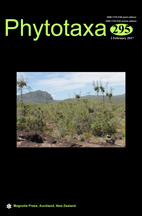Abstract
Unclear boundaries between species hinder identification in the field and in herbaria, especially in species groups that can only be distinguished on the basis of subtle morphological and ecological features. One such taxon is Ficinia indica, widespread in the Greater Cape Floristic Region, growing on deep sandy soils between sea level and 1000 m elevation. Within its range, several phylogenetically related and morphologically similar species co-occur or occupy distinct habitats. Studies in herbaria show species in the Ficinia indica complex to be largely misidentified based on the use of qualitative information. Here, we investigate whether the six taxa recognized, based on one or a few characters, are supported as distinct species based on multivariate analysis of macro-morphological data. Two of the taxa were mostly separated whereas the other four taxa overlapped in multivariate space, but all the taxa could be distinguished using a single or a combination of morphological and ecological characters. We uphold the four previously recognized taxa (Ficinia argyropus, F. elatior, F. indica, F. laevis) as species, describe two new species (F. arnoldii and F. montana), and provide a dichotomous key for their identification.

